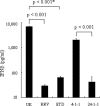Variation in antagonism of the interferon response to rotavirus NSP1 results in differential infectivity in mouse embryonic fibroblasts
- PMID: 19420080
- PMCID: PMC2704795
- DOI: 10.1128/JVI.00585-09
Variation in antagonism of the interferon response to rotavirus NSP1 results in differential infectivity in mouse embryonic fibroblasts
Abstract
Rotavirus NSP1 has been shown to function as an E3 ubiquitin ligase that mediates proteasome-dependent degradation of interferon (IFN) regulatory factors (IRF), including IRF3, -5, and -7, and suppresses the cellular type I IFN response. However, the effect of rotavirus NSP1 on viral replication is not well defined. Prior studies used genetic analysis of selected reassortants to link NSP1 with host range restriction in the mouse, suggesting that homologous and heterologous rotaviruses might use their different abilities to antagonize the IFN response as the basis of their host tropisms. Using a mouse embryonic fibroblast (MEF) model, we demonstrate that heterologous bovine (UK and NCDV) and porcine (OSU) rotaviruses fail to effectively degrade cellular IRF3, resulting in IRF3 activation and beta IFN (IFN-beta) secretion. As a consequence of this failure, replication of these viruses is severely restricted in IFN-competent wild-type, but not in IFN-deficient (IFN-alpha/beta/gamma receptor- or STAT1-deficient) MEFs. On the other hand, homologous murine rotaviruses (ETD or EHP) or the heterologous simian rotavirus (rhesus rotavirus [RRV]) efficiently degrade cellular IRF3, diminish IRF3 activation and IFN-beta secretion and are not replication restricted in wild-type MEFs. Genetic reassortant analysis between UK and RRV maps the distinctive phenotypes of IFN antagonism and growth restriction in wild-type MEFs to NSP1. Therefore, there is a direct relationship between the replication efficiencies of different rotavirus strains in MEFs and strain-related variations in NSP1-mediated antagonism of the type I IFN response.
Figures





Similar articles
-
Roles of VP4 and NSP1 in determining the distinctive replication capacities of simian rotavirus RRV and bovine rotavirus UK in the mouse biliary tract.J Virol. 2011 Mar;85(6):2686-94. doi: 10.1128/JVI.02408-10. Epub 2010 Dec 29. J Virol. 2011. PMID: 21191030 Free PMC article.
-
IRF3 inhibition by rotavirus NSP1 is host cell and virus strain dependent but independent of NSP1 proteasomal degradation.J Virol. 2009 Oct;83(20):10322-35. doi: 10.1128/JVI.01186-09. Epub 2009 Aug 5. J Virol. 2009. PMID: 19656876 Free PMC article.
-
Diversity of interferon antagonist activities mediated by NSP1 proteins of different rotavirus strains.J Virol. 2011 Mar;85(5):1970-9. doi: 10.1128/JVI.01801-10. Epub 2010 Dec 22. J Virol. 2011. PMID: 21177809 Free PMC article.
-
Rotavirus and reovirus modulation of the interferon response.J Interferon Cytokine Res. 2009 Sep;29(9):559-67. doi: 10.1089/jir.2009.0072. J Interferon Cytokine Res. 2009. PMID: 19694545 Free PMC article. Review.
-
Silencing the alarms: Innate immune antagonism by rotavirus NSP1 and VP3.Virology. 2015 May;479-480:75-84. doi: 10.1016/j.virol.2015.01.006. Epub 2015 Feb 25. Virology. 2015. PMID: 25724417 Free PMC article. Review.
Cited by
-
Innate immune responses to human rotavirus in the neonatal gnotobiotic piglet disease model.Immunology. 2010 Oct;131(2):242-56. doi: 10.1111/j.1365-2567.2010.03298.x. Immunology. 2010. PMID: 20497255 Free PMC article.
-
Rotavirus Interactions With Host Intestinal Epithelial Cells.Front Immunol. 2021 Dec 22;12:793841. doi: 10.3389/fimmu.2021.793841. eCollection 2021. Front Immunol. 2021. PMID: 35003114 Free PMC article. Review.
-
Rotavirus antagonism of the innate immune response.Viruses. 2009 Dec;1(3):1035-56. doi: 10.3390/v1031035. Epub 2009 Nov 24. Viruses. 2009. PMID: 21994581 Free PMC article.
-
Basal interferon signaling and therapeutic use of interferons in controlling rotavirus infection in human intestinal cells and organoids.Sci Rep. 2018 May 29;8(1):8341. doi: 10.1038/s41598-018-26784-9. Sci Rep. 2018. PMID: 29844362 Free PMC article.
-
Rotavirus immune responses and correlates of protection.Curr Opin Virol. 2012 Aug;2(4):419-25. doi: 10.1016/j.coviro.2012.05.003. Epub 2012 Jun 5. Curr Opin Virol. 2012. PMID: 22677178 Free PMC article. Review.
References
-
- Angel, J., M. A. Franco, H. B. Greenberg, and D. Bass. 1999. Lack of a role for type I and type II interferons in the resolution of rotavirus-induced diarrhea and infection in mice. J. Interferon Cytokine Res. 19655-659. - PubMed
-
- Azim, T., M. H. Zaki, G. Podder, N. Sultana, M. A. Salam, S. M. Rahman, K. Sefate, and D. A. Sack. 2003. Rotavirus-specific subclass antibody and cytokine responses in Bangladeshi children with rotavirus diarrhoea. J. Med. Virol. 69286-295. - PubMed
Publication types
MeSH terms
Substances
Grants and funding
LinkOut - more resources
Full Text Sources
Other Literature Sources
Medical
Research Materials
Miscellaneous

